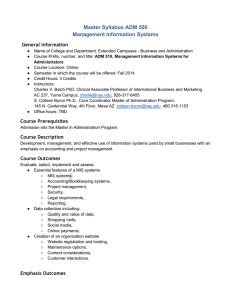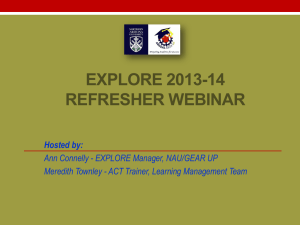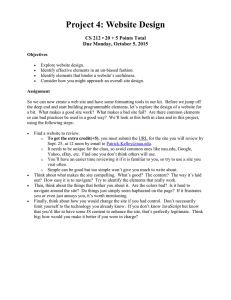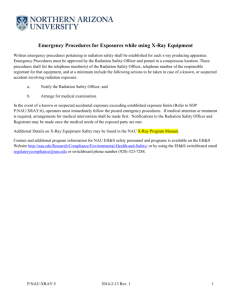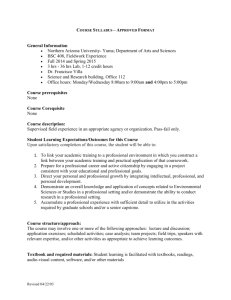me 465— machine design ii - nau.edu
advertisement
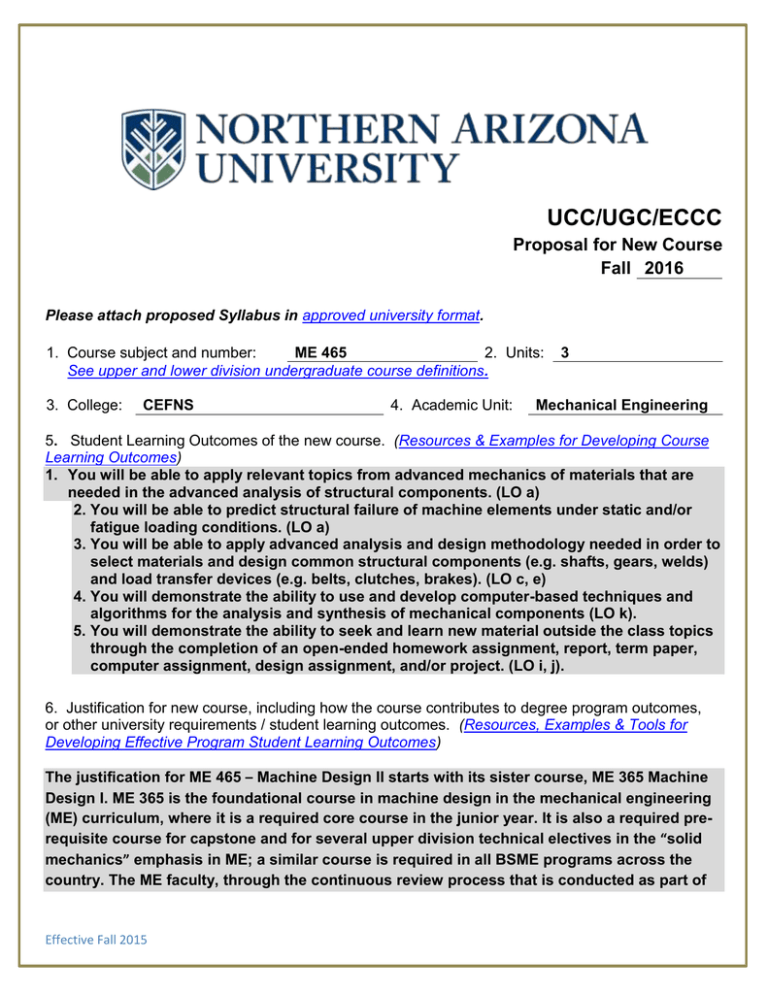
UCC/UGC/ECCC Proposal for New Course Fall 2016 Please attach proposed Syllabus in approved university format. 1. Course subject and number: ME 465 2. Units: See upper and lower division undergraduate course definitions. 3. College: CEFNS 4. Academic Unit: 3 Mechanical Engineering 5. Student Learning Outcomes of the new course. (Resources & Examples for Developing Course Learning Outcomes) 1. You will be able to apply relevant topics from advanced mechanics of materials that are needed in the advanced analysis of structural components. (LO a) 2. You will be able to predict structural failure of machine elements under static and/or fatigue loading conditions. (LO a) 3. You will be able to apply advanced analysis and design methodology needed in order to select materials and design common structural components (e.g. shafts, gears, welds) and load transfer devices (e.g. belts, clutches, brakes). (LO c, e) 4. You will demonstrate the ability to use and develop computer-based techniques and algorithms for the analysis and synthesis of mechanical components (LO k). 5. You will demonstrate the ability to seek and learn new material outside the class topics through the completion of an open-ended homework assignment, report, term paper, computer assignment, design assignment, and/or project. (LO i, j). 6. Justification for new course, including how the course contributes to degree program outcomes, or other university requirements / student learning outcomes. (Resources, Examples & Tools for Developing Effective Program Student Learning Outcomes) The justification for ME 465 – Machine Design II starts with its sister course, ME 365 Machine Design I. ME 365 is the foundational course in machine design in the mechanical engineering (ME) curriculum, where it is a required core course in the junior year. It is also a required prerequisite course for capstone and for several upper division technical electives in the “solid mechanics” emphasis in ME; a similar course is required in all BSME programs across the country. The ME faculty, through the continuous review process that is conducted as part of Effective Fall 2015 ABET-accreditation activities, identified some areas of this course where improvement was needed. A key recommendation that emerged was to cover in more detail topics that are associated with bolted joints, gears and shafts design. While course changes were made to accommodate more lectures on gears and shafts design, these took away time from other topics that are equally important for students’ performance in subsequent courses. As a result, a survey was carried out to identify practices in other peer mechanical engineering departments in offering the machine design course. This survey indicated that a significant number of departments offer two courses in machine design, giving students the opportunity to immerse in depth in the topics mentioned above, and to also be introduced to additional topics such as clutches, brakes, flexible mechanical elements, etc. This finding, combined with the observed increase in DFW rates in the course of up to 20% between 2005 and 2015 triggered the proposed change in this course offering. In addition, the ME department, informed by its continuous improvement process required for ABET-accreditation, has decided to make a significant modification to its curriculum in hopes of improving student performance in machine design. The change is to reduce the breadth of the topics covered on ME 365 syllabus, thus allowing more depth and mastery of the remaining topics, and to create a new machine design course, ME 465 Machine Design II, that covers the content dropped from ME 365, in more depth, and with additional topics appropriate for an ME student (and covered in other peer departments). ME 465 will be a “required” depth elective for ME students that elect to focus on the solid mechanics emphasis. 7. Course Title: MACHINE DESIGN II (max 100 characters including spaces) 8. Catalog course description (max. 60 words, excluding requisites): Fundamentals of mechanical design; stress, deflection, strength, lubrication, and design principles; design of mechanical elements: helical gears, bevel gears, worm gearing, shafts, clutches, breaks, flexible mechanical elements, bearings, permanent joints. 9. Will this course be part of any plan (major, minor or certificate) or sub plan (emphasis)? Yes If yes, list and include the appropriate plan proposal. Mechanical Engineering; B.S.E. No 10. Does this course duplicate content of existing courses? Yes No If yes, list the courses with duplicate material. If the duplication is greater than 20%, explain why NAU should establish this course, and include applicable support/correspondence. This course doesn’t duplicate material from other courses. It builds on material introduced in ME365 – Machine Design I to introduce advanced methods of analysis and design of new machine elements. 11. Grading option: 12. Proposed Co-convene with: Effective Fall 2015 Letter grade Pass/Fail 14a. UGC approval date*: Both See co-convening policy. *Must be approved by UGC before UCC submission, and both course syllabi must be presented. 13. Proposed Cross-list with: See cross listing policy. 14. May course be repeated for additional units? 14a. If yes, maximum units allowed? 14b. If yes, may course be repeated for additional units in the same term? Yes No Yes No CS 122, CENE 253, ME 15. Proposed Prerequisites: 252, ME 340, ME 365 If prerequisites, include the rationale for the prerequisites. This course builds on material, and requires application of knowledge, introduced in CENE 253, ME252, ME340 and ME365. Computer usage will be required as part of the course work, thus CS 122 is a necessary prerequisite. 16. Proposed Co requisites: If co requisites, include the rationale for the co requisites. 17. Does this course include combined lecture and lab components? Yes If yes, include the units specific to each component in the course description above. No 18. Does this course include an experiential learning component? No 19. Class Instruction Mode: In-person If In-person or Blended, where will the course be offered? 20. Which terms will the course be offered? Fall Winter Other Yes Online FLGMTN Blended Other Spring Summer (Fall/Even Yrs, Spring/Odd Yrs, Intermittent, etc.) 21. Do you anticipate this course will be scheduled outside the regular term? Yes No If yes, please refer to: http://nau.edu/Registrar/Faculty-Resources/Schedule-of-Classes-Maintenance/ 22. Will there be a course fee? If yes, please refer to: http://nau.edu/Registrar/Faculty-Resources/Course-Fees/ Yes No 23. Is this course being proposed for Liberal Studies designation? Yes No 24. Is this course being proposed for Diversity designation? Yes No Answer 23-24 for UCC/ECCC only: Effective Fall 2015 FLAGSTAFF MOUNTAIN CAMPUS Scott Galland Reviewed by Curriculum Process Associate 1/11/2016 Date Approvals: F. Ernesto Penado 12/8/2014 Department Chair/Unit Head (if appropriate) Date Chair of college curriculum committee Date Dean of college Date For Committee use only: UCC/UGC Approval Date EXTENDED CAMPUSES Reviewed by Curriculum Process Associate Date Approvals: Academic Unit Head Date Division Curriculum Committee (Yuma, Yavapai, or Personalized Learning) Date Division Administrator in Extended Campuses (Yuma, Yavapai, or Personalized Learning) Date Faculty Chair of Extended Campuses Curriculum Committee (Yuma, Yavapai, or Personalized Learning) Date UGC Approval (Graduate-Level Courses Only) Date Effective Fall 2015 Chief Academic Officer; Extended Campuses (or Designee) Date From: F Ernesto Penado Sent: Tuesday, December 08, 2015 4:37 PM To: Stuart S Galland <Stuart.Galland@nau.edu> Cc: Tom Acker <Tom.Acker@nau.edu>; Constantin Ciocanel <Constantin.Ciocanel@nau.edu> Subject: ME course and program changes Hi Scott, Here are the materials for the ME 365, 395, 440 and 465 course changes with syllabi, and the associated program changes. I have also added my electronic approval. Please note that on p. 3 of the program of study form, there is a question about whether ENG 105 should be included at that location (highlighted in light blue). Otherwise, ENG 105 only appears as a footnote in the POS. Also, I added ME 456 (the new Engineering Modeling of Nonlinear Systems course) to the list of depth electives on p. 4 of the POS, although ME 456 is going through the approval process as well for new course approval. Thanks, -Ernesto ----------------F. Ernesto Penado, Ph.D. Professor and Chair Department of Mechanical Engineering Northern Arizona University NAU COLLEGE OF ENGINEERING, FORESTRY AND NATURAL SCIENCE MECHANICAL ENGINEERING DEPARTMENT ME 465— MACHINE DESIGN II Spring 2017 Catalog Description ME 465 – Machine Design II (3 credits). Fundamentals of mechanical design; stress, deflection, strength, lubrication, and design principles; design of mechanical elements: helical gears, bevel gears, worm gearing, shafts, clutches, breaks, flexible mechanical elements, bearings, permanent joints. Letter grade only. Textbook: Lecture: Shigley’s Mechanical Engineering Design, 9th Ed., R.G. Budynas & J.K. Nisbett, McGraw-Hill, 2011, ISBN-13 9780077942908. TuTh 8:00 – 9:15am, Bldg. 69, Rm 101 Faculty: Constantin Ciocanel, PhD, Associate Professor, Rm 211 Prerequisite Courses: ME 252 Applied Mechanics Dynamics; CENE 253 Mechanics of Materials; ME 340 Materials Science; ME 365 Machine Design; CS 122 Intro to Computer Programming Prerequisite Topics: 1. 2. 3. 4. 5. 6. 7. Effective Fall 2015 Multivariable calculus; Vector algebra Understanding of force-equilibrium relations; free-body diagrams Shear and moment diagrams Two dimensional stress/strain at a point: principal stresses and strains, Mohr’s circle Deflections of elastic members Theories of static failure Basic knowledge of statistics 8. Understanding of the physical and engineering properties of materials 9. Computer programming and/or computer analysis tools Course Learning Objectives: 1. To introduce you to the tools and methodology needed to design and analyze mechanical components. 2. To illustrate the need for independent thinking and learning needed to solve the types of design problems not specifically covered in class. 3. You will demonstrate an understanding of the statistical nature of the variables involved in the design process, and will be able to use stochastic analysis to determine the reliability when the stress and strength distributions are known at the critical location in a part. 4. To provide you with the advanced concepts necessary to define the final shape, size, and material of a particular machine element so that it will not fail under the loading and environmental conditions expected in service. 5. To teach you how to apply computer-based techniques in the analysis, design, and selection of components which are commonly used in the design of complete mechanical systems. Course Learning Outcomes1: 1. You will be able to apply relevant topics from advanced mechanics of materials that are needed in the analysis of structural components. (LO a) 2. You will be able to predict structural failure under static and/or fatigue loading conditions. (LO a) 3. You will be able to apply the proper analysis and design methodology needed in order to select materials and design common structural components such as shafts, gears, and bolts. (LO c, e) 4. You will demonstrate the ability to use and develop computer-based techniques and algorithms for the analysis and synthesis of mechanical components (LO k). 5. You will demonstrate the ability to seek and learn new material outside the class topics through the completion of an open-ended homework assignment, report, term paper, computer assignment, design assignment, and/or project. (LO i, j). 1The numbers in parenthesis (e.g., LO a, etc.) correspond to the a through k ABET Learning Objectives. Course Topics2,3: 1. 2. 3. 4. 5. 6. 7. 8. 9. 10. 11. Shaft design [2] Keys, set screws, limits and fits [2] Helical gears [2] Bevel gears [2] Worm gearing [2] Cylindrical and tapered bearings [3] Clutches and breaks [4] Flexible mechanical elements [3] Lubrication [3] Permanent joints [3] Finite element analysis [1] 215 week semester, TTh, 27 lectures, 3 exams. number in square brackets indicates the number of lectures devoted to the topic. 3The Reading assignments/ Homework/ Quizzes/Exams: Effective Fall 2015 Reading assignments must be completed before the lecture. The importance of completing these reading assignments, for your success in this course and beyond, cannot be overstated. Homework is part of your grade and is due at the beginning of the lecture period. Late homework will be accepted only under extreme circumstances (e.g., serious illness, institutional excuse), and will require written verification. If you have an institutional excuse, arrangements must be made with the instructor prior to the date when you will be absent. Remember also that you can always turn in an assignment early. You are strongly encouraged to complete your assigned homework; this will help you better understand the material. Homework assignments must be done in a professional manner (neat, orderly, etc.), on engineering paper, using a GIVEN, FIND, SOLUTION format. GIVEN: A restatement, in your own words, of the information given in the problem statement. FIND: A statement of what is required to find in the problem from the given information. SOLUTION: Your solution to the problem. When plots or iterative calculations are required in a HW problem, you must use a computer program to generate the plots/solve the problem. No hand generated plots or calculations will be graded. Quizzes will be used to test the completion and understanding of the reading assignments, and to assess, progressively, the level of understanding of the taught material. All quizzes will be administered through Bblearn – please complete them as assigned; no make-up quizzes will be given. Exams will be used to comprehensively assess the level of understanding of the taught material. Make-up exams will be given only under extreme circumstances (e.g., serious illness, institutional excuse), and will require written verification. It is expected that all your work will be neat, readable, and in logical order. If it is not, you will not receive partial credit. Project: Assessment: The project is a semester long assignment. Students are expected to design a two stage gear box to be used in either a small wind turbine, weed trimmer, or mini-cart. The gears, shafts, keys, and bearings will be designed against stress and/or defelection failure. Selection of materials for the shaft, gears and keys, along with shaft and gears’ finish and heat treatments is also required. Finally, a gear box casing and lubrication plan have to be included. Your final grade will be based upon the weighting system provided below. You may receive up to 2% toward your grade for perfect course attendance. RELATIVE WEIGHT Homework Quizzes Exam #1 Exam #2 Exam #3 Project Final Exam Total 7.5% 7.5% 15% 15% 15% 20% 20% 100% GRADE DISTRIBUTION A 90%+ B 80 to 89% C 70 to 79% D 60 to 69% F Below 60% Professional Component: Engineering Science: 30% Engineering Design: 70% Policies: Make-up exams are given only when an extreme circumstance (e.g., serious illness, institutional excuse) doesn’t allow the student to take a class scheduled exam. In such a case, written verification is required. No make-up quizzes will be given. Attendance As stated in the Class Attendance policy in the NAU General Catalog, students are expected to assume responsibility for regular class attendance. When absence is unavoidable, students should report the reason to the instructor and assume the responsibility for any work they miss. Instructors are under no obligation to make special arrangements for students who have been absent unless the student has an institutional excuse. Effective Fall 2015 NORTHERN ARIZONA UNIVERSITY POLICY STATEMENTS FOR COURSE SYLLABI SAFE ENVIRONMENT POLICY NAU’s Safe Working and Learning Environment Policy prohibits sexual harassment and assault, and discrimination and harassment on the basis of sex, race, color, age, national origin, religion, sexual orientation, gender, gender identity, disability, or veteran status by anyone at this university. Retaliation of any kind as a result of making a complaint under the policy or participating in an investigation is also prohibited. The Director of the Equity and Access Office (EAO) serves as the university’s compliance officer for affirmative action, civil rights, and Title IX, and is the ADA/504 Coordinator. EAO also assists with religious accommodations. You may obtain a copy of this policy from the college dean’s office or from NAU’s Equity and Access Office website nau.edu/diversity/. If you have questions or concerns about this policy, it is important that you contact the departmental chair, dean’s office, the Office of Student Life (928-523-5181), or NAU’s Equity and Access Office (928) 523-3312 (voice), (928) 523-9977 (fax), (928) 523-1006 (TTD) or equityandaccess@nau.edu. STUDENTS WITH DISABILITIES If you have a documented disability, you can arrange for accommodations by contacting Disability Resources (DR) at 5238773 (voice) or 523-6906 (TTY), dr@nau.edu (e-mail) or 928-523-8747 (fax). Students needing academic accommodations are required to register with DR and provide required disability related documentation. Although you may request an accommodation at any time, in order for DR to best meet your individual needs, you are urged to register and submit necessary documentation (www.nau.edu/dr) 8 weeks prior to the time you wish to receive accommodations. DR is strongly committed to the needs of student with disabilities and the promotion of Universal Design. Concerns or questions related to the accessibility of programs and facilities at NAU may be brought to the attention of DR or the Office of Affirmative Action and Equal Opportunity (523-3312). ACADEMIC CONTACT HOUR POLICY Based on the Arizona Board of Regents Academic Contact Hour Policy (ABOR Handbook, 2-224), for every unit of credit, a student should expect, on average, to do a minimum of three hours of work per week, including but not limited to class time, preparation, homework, studying. ACADEMIC INTEGRITY Integrity is expected of every member of the NAU community in all academic undertakings. Integrity entails a firm adherence to a set of values, and the values most essential to an academic community are grounded in honesty with respect to all intellectual efforts of oneself and others. Academic integrity is expected not only in formal coursework situations, but in all University relationships and interactions connected to the educational process, including the use of University resources. An NAU student’s submission of work is an implicit declaration that the work is the student’s own. All outside assistance should be acknowledged, and the student’s academic contribution truthfully reported at all times. In addition, NAU students have a right to expect academic integrity from each of their peers. Individual students and faculty members are responsible for identifying potential violations of the university’s academic integrity policy. Instances of potential violations are adjudicated using the process found in the university Academic Integrity Policy. RESEARCH INTEGRITY The Responsible Conduct of Research policy is intended to ensure that NAU personnel including NAU students engaged in research are adequately trained in the basic principles of ethics in research. Additionally, this policy assists NAU in meeting the RCR training and compliance requirements of the National Science Foundation (NSF)-The America COMPETES Act (Creating Opportunities to Meaningfully Promote Excellence in Technology, Education and Science); 42 U.S.C 18620-1, Section 7009, and the National Institutes of Health (NIH) policy on the instruction of the RCR (NOT-OD-10019; “Update on the Requirement for Instruction in the Responsible Conduct of Research”). For more information on the policy and the training activities required for personnel and students conducting research, at NAU, visit: http://nau.edu/Research/Compliance/Research-Integrity/ SENSITIVE COURSE MATERIALS University education aims to expand student understanding and awareness. Thus, it necessarily involves engagement with a wide range of information, ideas, and creative representations. In the course of college studies, students can expect to encounter—and critically appraise—materials that may differ from and perhaps challenge familiar understandings, ideas, and beliefs. Students are encouraged to discuss these matters with faculty. Effective Fall 2015 CLASSROOM DISRUPTION POLICY Membership in the academic community places a special obligation on all participants to preserve an atmosphere conducive to a safe and positive learning environment. Part of that obligation implies the responsibility of each member of the NAU community to maintain an environment in which the behavior of any individual is not disruptive. Instructors have the authority and the responsibility to manage their classes in accordance with University regulations. Instructors have the right and obligation to confront disruptive behavior thereby promoting and enforcing standards of behavior necessary for maintaining an atmosphere conducive to teaching and learning. Instructors are responsible for establishing, communicating, and enforcing reasonable expectations and rules of classroom behavior. These expectations are to be communicated to students in the syllabus and in class discussions and activities at the outset of the course. Each student is responsible for behaving in a manner that supports a positive learning environment and that does not interrupt nor disrupt the delivery of education by instructors or receipt of education by students, within or outside a class. The complete classroom disruption policy is in Appendices of NAU’s Student Handbook. August 25, 2015 Effective Fall 2015

